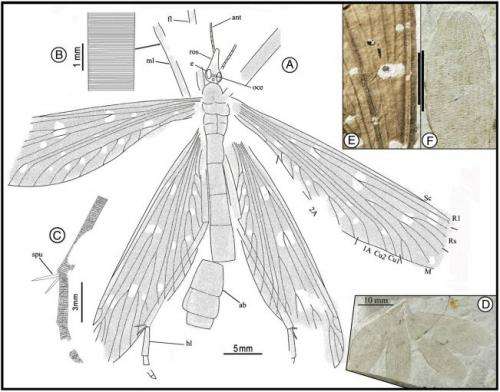November 28, 2012 report
Jurassic insect that mimicked ginkgo leaves discovered

(Phys.org)—Researchers working in China have discovered an insect that lived 165 million years ago that they believe used its wings to mimic the leaves of an ancient ginkgo tree. The fossil finding, the team writes in their paper published in the Proceedings of the National Academy of Sciences, is one of the few that shows that early insects mimicked non-flowering plants millions of years before doing so with angiosperms.
The inch and a half long fossil specimen was first overlooked, the team says, as those that found it first believed it to be a (now extinct) five lobed ginkgo leaf sample embedded within ancient rock. Upon closer inspection, the researchers discovered that the specimen was actually that of a fossilized scorpionfly, which is known more commonly as a hangingfly (Juracimbrophlebia ginkgofolia), because of its tendency to hang from branches waiting for prey to pass by. It was found in the northeastern part of Inner Mongolia. The scorpionfly gets its name from its oversized male genitalia that resemble a scorpion stinger. To mimic surrounding ginkgo leaves, the insect would latch onto a branch, hang down and spread its wings wide open.
The researchers suggest that the insect likely evolved its mimicry abilities to help it evade predators or to help it hide from prey, as is seen with many modern insects. The first attribute would have been most useful as close inspection of the insect revealed weak wings and legs. They noted also that it was possible that the insect and the ginkgo formed a partnership of sorts with the tree providing shelter and the hangingfly eating other bugs that might seek to feed on the trees' leaves.
The discovery of the hangingfly fossil adds to the knowledgebase of insects that mimic non-flowering plants. Most mimicking insects going back 100 million years tend to mimic angiosperms. The newly discovered hangingfly fossil predates other fossilized mimicking insects by approximately 40 million years.
Both the fossilized hangingfly and the ginkgo plant that it mimicked, date back to the heyday of the dinosaurs and thus it's quite possible that the plant served as food for them and other large herbivores.
More information: Jurassic mimicry between a hangingfly and a ginkgo from China, PNAS, Published online before print November 26, 2012, doi: 10.1073/pnas.1205517109
Abstract
A near-perfect mimetic association between a mecopteran insect species and a ginkgoalean plant species from the late Middle Jurassic of northeastern China recently has been discovered. The association stems from a case of mixed identity between a particular plant and an insect in the laboratory and the field. This confusion is explained as a case of leaf mimesis, wherein the appearance of the multilobed leaf of Yimaia capituliformis (the ginkgoalean model) was accurately replicated by the wings and abdomen of the cimbrophlebiid Juracimbrophlebia ginkgofolia (the hangingfly mimic). Our results suggest that hangingflies developed leaf mimesis either as an antipredator avoidance device or possibly as a predatory strategy to provide an antiherbivore function for its plant hosts, thus gaining mutual benefit for both the hangingfly and the ginkgo species. This documentation of mimesis is a rare occasion whereby exquisitely preserved, co-occurring fossils occupy a narrow spatiotemporal window that reveal likely reciprocal mechanisms which plants and insects provide mutual defensive support during their preangiospermous evolutionary histories.
Journal information: Proceedings of the National Academy of Sciences
© 2012 Phys.org



















